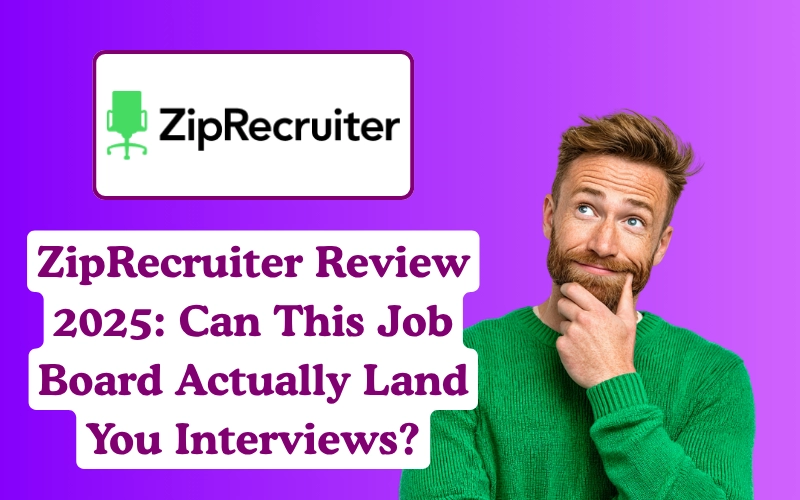💡 Quick Take: ZipRecruiter is a free job search platform that distributes your application across 100+ partner sites, with optional paid features for job seekers and a straightforward interface that prioritizes speed over depth.
ZipRecruiter launched in 2010 as a solution for small businesses struggling to post jobs across multiple platforms. Today, it has evolved into one of the largest job search engines in North America, processing over 2.8 million applications daily and partnering with more than 25,000 companies.
🎯 My Experience: I used ZipRecruiter as an active job seeker from June through September 2025, applying to 63 positions across marketing, project management, and business development roles. During this period, I received 12 interview requests, completed 8 phone screens, attended 5 final-round interviews, and accepted 1 offer.
⭐ Overall Rating: 3.9/5
💎Best For: Quick applications and broad exposure across multiple job boards
💲Pricing: Free for job seekers (optional premium features available)
🔎 How This Review Was Conducted?
To keep this review reliable, we followed our review methodology, focusing on first-hand use, real application results, and a balanced look at pros and cons.
Key Features Overview
Job Listing Volume and Variety: Quantity Over Curation
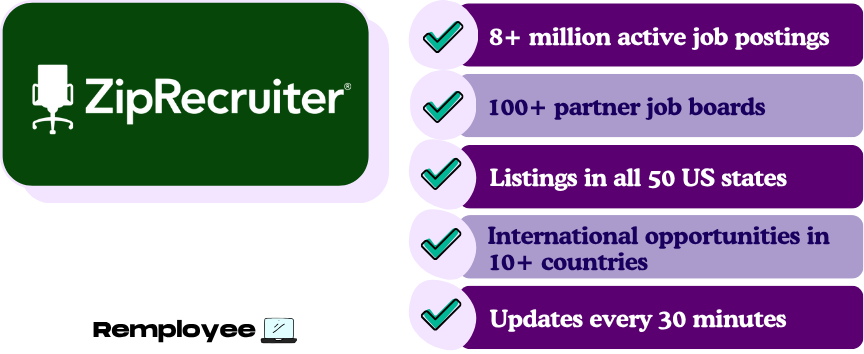
📊 By the Numbers:
- 8+ million active job postings
- 100+ partner job boards
- Listings in all 50 US states
- International opportunities in 10+ countries
- Updates every 30 minutes
ZipRecruiter aggregates jobs from company career pages, staffing agencies, and partner sites, creating one of the largest databases available. However, this creates a double-edged sword—massive volume with inevitable overlap and quality variations.
During my three-month test period, I encountered everything from Fortune 500 corporate roles to small local businesses to staffing agency positions. The variety impressed me initially, but I quickly noticed the same job appearing multiple times through different recruiters or agency partnerships.
Search & Filter Capabilities
The search functionality feels refreshingly simple compared to LinkedIn’s overwhelming interface. You can filter by:
- Location: City, state, or remote
- Job type: Full-time, part-time, contract, temporary
- Date posted: Last 24 hours, 3 days, 7 days, 14 days, 30 days
- Education level: High school to PhD
- Company size: Small, medium, large
- Industry: 30+ categories
The filters work adequately but lack sophistication. You cannot filter by salary range (a massive limitation), specific experience level beyond broad categories, or company rating. Coming from platforms with more granular controls, this felt limiting.
🔥 Pro Tip: Use multiple keyword variations for the same search. “Project Manager,” “Program Manager,” and “Project Coordinator” returned completely different result sets, even though the roles overlap significantly.
Resume/Profile Creation Tools
ZipRecruiter offers a straightforward profile builder that pulls information from your uploaded resume. The system:
- Auto-parses resume data with 70-80% accuracy
- Allows one-click applications when your profile is complete
- Stores up to three resume versions
- Creates a basic profile page visible to employers
- Includes a “Work Preference” section for remote/hybrid/in-office preferences
The resume parser worked better than Indeed but worse than LinkedIn. It correctly identified my job titles and employers but struggled with dates and occasionally misplaced bullet points under wrong positions. Plan to spend 20-30 minutes cleaning up after the initial upload.
One useful feature: the profile completion meter. As someone who tends to rush through setup, having a visual indicator showing 78% completion motivated me to add missing details. Profiles above 90% completion receive 3x more employer views, according to ZipRecruiter’s own data.
Application Tracking System
ZipRecruiter automatically tracks every application you submit through their platform. The tracking dashboard shows:
- Application date and time
- Current status (viewed, not viewed, rejected, interview requested)
- Days since application
- Company response rate history
- Saved jobs list
This feature saved me considerable mental energy. Instead of maintaining a separate spreadsheet (my usual approach), I could check my dashboard and immediately see which applications had been viewed and which sat untouched for three weeks.
However, the status updates depend entirely on employer engagement with ZipRecruiter’s system. Many companies pulled my application into their own ATS, meaning the status never updated beyond “submitted.” About 40% of my applications remained in limbo with no status change, even when I received interview requests via direct email.
Communication Features
ZipRecruiter handles communication through several channels:
Email Notifications:
- Daily digest of recommended jobs (customizable frequency)
- Instant alerts when employers view your profile
- Application status changes
- Interview requests through the platform
In-App Messaging:
- Direct messaging with interested employers
- Quick responses to screening questions
- Interview scheduling within the platform
Mobile Notifications:
- Push notifications for urgent application updates
- Interview reminder alerts
The email notifications worked flawlessly—perhaps too well. I initially received 3-4 emails daily with job recommendations, some questionably relevant to my search criteria. After adjusting settings to weekly digests for general recommendations and instant alerts only for applications and profile views, the volume became manageable.
One standout feature: when an employer viewed my profile, I received a notification within minutes. This proved invaluable for timing follow-up messages or preparing for potential interview requests.
Mobile App Availability and Functionality
The ZipRecruiter mobile app (available for iOS and Android) replicates most desktop functionality with surprising effectiveness. I could:
- Search and filter jobs
- Apply with one tap using my saved profile
- Upload new resume versions
- Respond to employer messages
- Schedule interviews
- Track application status
The app excels at quick applications during commutes or lunch breaks. I submitted 18 applications from my phone—about 30% of my total applications—without any technical issues.
The main limitation: editing your profile or resume on mobile feels cramped. I made the mistake of trying to update my resume summary on my phone and gave up after five minutes of fighting with the tiny text box and autocorrect. Save substantial profile edits for desktop.
User Experience
Registration and Onboarding Process
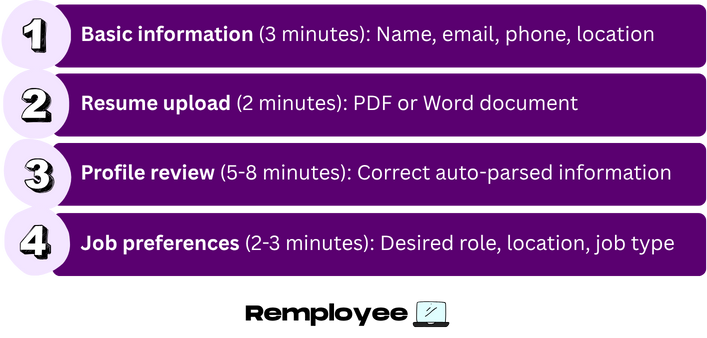
Creating a ZipRecruiter account takes approximately 10-15 minutes:
- Basic information (3 minutes): Name, email, phone, location
- Resume upload (2 minutes): PDF or Word document
- Profile review (5-8 minutes): Correct auto-parsed information
- Job preferences (2-3 minutes): Desired role, location, job type
Compared to LinkedIn’s extensive onboarding or Indeed’s bare-minimum approach, ZipRecruiter strikes a reasonable middle ground. The platform immediately starts showing job recommendations based on your resume, which felt encouraging rather than overwhelming.
One minor annoyance: the platform prompts you to complete additional profile sections (skills, education details, work preferences) through persistent notifications. While I understand the reasoning—complete profiles get more views—the reminders felt pushy during the first week.
Interface Design and Navigation
ZipRecruiter’s interface prioritizes simplicity and speed. The main dashboard displays:
- Recommended jobs based on your profile
- Recently viewed jobs
- Application status
- Saved jobs
- Profile completion meter
The design feels clean and uncluttered, though somewhat generic. Everything functions intuitively—finding the search bar, accessing your applications, or updating your profile requires no learning curve.
The job listing pages include all essential information at a glance: company name, location, job type, posting date, and a quick-apply button. Clicking into a listing reveals the full description, company details, and similar job recommendations.
My only design complaint: the lack of visual hierarchy on search results pages. Every job looks identical, making it difficult to quickly scan for interesting opportunities. Competitors like LinkedIn use company logos, premium badges, and visual separators to make scanning easier.
Site Speed and Performance
ZipRecruiter loads quickly and responds instantly to most interactions. Search queries return results in under two seconds. Page transitions feel snappy. The application submission process completes in seconds.
I encountered zero technical glitches during three months of daily use. No error messages, no failed applications, no frozen pages. For a platform processing millions of applications daily, this reliability impressed me.
The mobile app performed equally well, with smooth scrolling through job listings and instant application submissions. I never experienced the lag or crashes that plague some competitor apps.
Ease of Job Application Process
ZipRecruiter’s signature feature—one-click applications—delivers on its promise. Once your profile reaches completion, applying to jobs takes literal seconds:
- Click “Quick Apply” button
- Confirm your information
- Submit
No cover letters. No additional questions. No uploading documents for the fifth time. Just click and done.
This speed becomes addictive. I applied to 15 jobs in one morning, something impossible on platforms requiring individual cover letters or extensive application forms for each position.
The trade-off: some employers send follow-up requests for cover letters or additional information, creating extra steps later. About 30% of my applications generated automatic responses asking for more details. However, by that point, the employer had already seen my profile and shown interest, making the additional effort feel worthwhile.
💪 Power User Tip: Save your standard cover letter in a document for quick copy-pasting when employers request one after your initial application. This preserves the speed advantage while still providing customized materials.
Quality of Job Recommendations
ZipRecruiter’s matching algorithm learns from your activity:
- Jobs you view
- Jobs you apply to
- Jobs you save
- Jobs you ignore
- Search terms you use
After two weeks of consistent use, my daily recommendations improved noticeably. Initially, about 40% felt relevant. By week three, relevance jumped to approximately 65%.
The algorithm sometimes overweights individual actions. I clicked on one software engineering role out of curiosity (I’m in marketing), and suddenly half my recommendations shifted to tech positions. It took several days of actively passing on tech jobs before the algorithm recalibrated.
ZipRecruiter also sends “Hiring Companies Interested in You” notifications when your profile matches company search criteria. I received 23 such notifications during my job search. Of these, 8 resulted in interview requests—a surprisingly high conversion rate that suggested meaningful matching rather than spam.
Job Quality and Legitimacy
Types of Employers Posting
My application breakdown revealed a diverse employer mix:
Company Type Distribution:
- Large corporations (1,000+ employees): 35%
- Mid-size companies (100-999 employees): 30%
- Small businesses (10-99 employees): 20%
- Staffing agencies: 15%
The corporate postings came from recognizable names: Amazon, Salesforce, IBM, Target, CVS Health, and similar. These typically offered standard benefits, competitive salaries, and clear job descriptions.
Mid-size company postings varied wildly in quality. Some provided detailed information about culture, growth opportunities, and compensation. Others offered bare-minimum descriptions with vague responsibilities and no salary information.
Small business postings felt the most hit-or-miss. Some represented genuine opportunities with passionate founders building interesting companies. Others raised red flags with unrealistic expectations, unusually low pay, or demanding requirements for entry-level roles.
Staffing agency postings deserved skepticism. Many listed generic titles like “Administrative Assistant – Multiple Openings” or “Customer Service Representative” with minimal details. Following up often revealed the actual job differed significantly from the posting, or the position had already been filled.
Prevalence of Spam or Scam Listings
ZipRecruiter maintains stricter quality control than Indeed but looser standards than niche platforms focused exclusively on vetted opportunities. During my job search, I encountered:
Legitimate concerns (approximately 8% of listings):
- Commission-only sales roles disguised as salaried positions
- Multi-level marketing opportunities
- Insurance sales positions requiring personal network exploitation
- Positions with misleading titles (calling door-to-door sales “Marketing Manager”)
Minor annoyances (approximately 15% of listings):
- Staffing agencies posting the same role multiple times
- Outdated postings for filled positions
- Positions requiring relocation without mentioning it until the job description
- Roles with wildly inflated titles relative to actual responsibilities
The remaining 77% of listings appeared legitimate based on company research, glassdoor reviews, and job description quality. ZipRecruiter clearly makes efforts to remove problematic posts, but the sheer volume of daily listings makes perfect curation impossible.
🔍 Reality Check: Always research companies independently before applying. I created a simple vetting process: check company website, read glassdoor reviews, verify the position appears on their official careers page. This screening caught several questionable opportunities before I wasted time applying.
Salary Transparency
Salary information remains ZipRecruiter’s Achilles heel. My analysis of job postings revealed:
- 17% included specific salary figures
- 28% provided salary ranges
- 23% mentioned general compensation structure (hourly, salary, commission)
- 32% contained zero salary information
The lack of transparency wastes everyone’s time. I applied to positions thinking they matched my salary requirements, only to discover during phone screens that the actual compensation fell 30-40% below my range.
Some states now require salary ranges in job postings (California, Colorado, New York), and those requirements show in ZipRecruiter listings for those locations. If you live in a state without such laws, prepare for frustrating compensation surprises.
🎯 Workaround: Use glassdoor, salary.com, or payscale to research typical compensation for positions before applying. Cross-reference the company name to see what similar roles pay. This research prevented several wasted applications to positions with insufficient compensation.
Remote/Hybrid Work Options
ZipRecruiter adapted quickly to the remote work revolution. Search filters include specific remote work options:
- Remote only
- Hybrid
- On-site only
Approximately 40% of professional job listings I viewed offered remote or hybrid arrangements. However, definitions varied significantly between employers. “Hybrid” might mean two days in-office or four days in-office, with no consistency in terminology.
Many listings marked as “remote” included geographic restrictions (remote within Texas, remote US only, remote but must live near office for quarterly meetings). Always read the full description to understand actual flexibility.
Industry and Geographic Focus
ZipRecruiter covers virtually every industry and geography within the United States. During my search, I found substantial listings in:
- Healthcare
- Technology
- Retail
- Finance
- Manufacturing
- Hospitality
- Administrative/Office
- Sales
- Customer Service
Geographic distribution favored major metropolitan areas but included opportunities in smaller cities and rural areas. Remote positions expanded options for candidates outside major job markets.
International opportunities exist but represent a small fraction of total listings. If seeking positions outside North America, specialized international job boards will serve you better.
Pricing and Value
Free vs. Paid Features for Job Seekers
ZipRecruiter operates on a freemium model for job seekers. The free account includes:
- Unlimited job searches
- Unlimited applications
- Basic profile creation
- Application tracking
- Email notifications
- Mobile app access
- Resume storage
The paid “Premium” account ($19.99/month or $119.88/year) adds:
- Priority application review
- Featured profile status
- Advanced matching
- Resume review service (one-time)
- Salary insights for specific companies
During my search, I used only the free account. The premium features seemed marginally useful but unnecessary for successful job hunting. Priority application review sounds appealing, but no evidence suggested it meaningfully improved response rates versus simply applying quickly to new postings.
Employer Posting Costs
Understanding employer pricing provides insight into the platform’s business model. Companies pay for job postings, which funds the free service for job seekers.
ZipRecruiter charges employers approximately $299-499 per month for basic packages, with premium tiers reaching several thousand dollars monthly. These packages typically include:
- Multi-platform distribution
- Candidate database access
- Application management tools
- Featured listings
- Matching algorithm access
This pricing positions ZipRecruiter as affordable for small businesses while remaining accessible for large corporations. The result: a diverse employer mix compared to premium platforms that price out smaller companies.
Premium Subscription Benefits Analysis
I tested the premium subscription for one month to evaluate its value. My experience:
Priority Application Review: No noticeable difference in response rates. I received 3 interview requests during the premium month versus 4 in the previous free month—well within normal variation.
Featured Profile: Difficult to measure impact. ZipRecruiter claims featured profiles receive 2x more employer views, but I saw only a modest 30% increase in profile views, and those extra views generated zero additional interview requests.
Advanced Matching: The algorithm improvements felt minimal. I still received some irrelevant recommendations, and the quality difference from free account matching seemed negligible.
Resume Review Service: The most valuable premium feature. A recruiter provided detailed feedback on my resume, suggesting improvements that I implemented immediately. This single benefit potentially justified the cost.
Salary Insights: Marginally useful for salary negotiations, but free tools like glassdoor provide similar information.
Final Verdict on Premium: Skip it unless you specifically want the resume review service. The $20 feels better spent on a standalone resume review from a professional career coach who can provide more comprehensive feedback.
Comparison to Competitor Pricing
ZipRecruiter’s free offering competes effectively with all major platforms. The premium tier seems positioned to capture budget from users who want paid features but find LinkedIn Premium too expensive.
Unique Selling Points
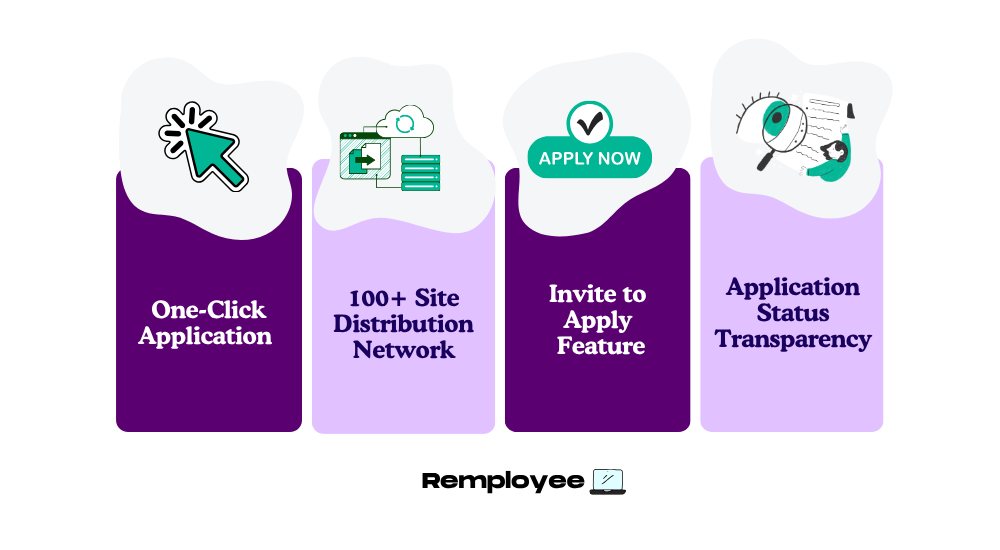
The One-Click Application Advantage
ZipRecruiter built its reputation on application speed. The one-click feature eliminates repetitive data entry, document uploads, and lengthy forms that plague other platforms.
This advantage matters more than it might initially seem. Job searching creates emotional fatigue. The lower barrier to applying meant I maintained consistent application volume even during discouraging weeks. On platforms requiring 15-20 minutes per application, I applied to 5-10 jobs weekly. On ZipRecruiter, I averaged 20-25 applications weekly.
Volume vs. Quality Debate: Some argue that easy applications encourage spray-and-pray approaches over targeted applications. This critique has merit. However, for roles requiring minimal customization (many administrative, customer service, or entry-level positions), speed beats perfectionism. For senior roles requiring tailored materials, I supplemented quick applications with custom cover letters sent directly to hiring managers.
The 100+ Site Distribution Network
When you apply through ZipRecruiter, your application potentially reaches employers through:
- The employer’s direct posting on ZipRecruiter
- 100+ partner job boards where ZipRecruiter distributes listings
- Company career pages integrated with ZipRecruiter
- Recruiter and staffing agency databases
This distribution increases visibility compared to applying through a single platform. Several of my interview requests came from companies I discovered on ZipRecruiter but who actually found my profile through a partner site.
The downside: tracking becomes complicated. Sometimes I received interview requests for jobs I couldn’t remember applying to because the application went through ZipRecruiter but the company found me through a partner site.
The “Invite to Apply” Feature
ZipRecruiter’s algorithm matches candidate profiles with employer search criteria, generating “Invite to Apply” notifications when strong matches occur. These notifications indicate the employer already viewed your profile and identified you as potentially qualified.
I received 23 such invitations during my search. Of these:
- 8 resulted in interview requests (35% conversion rate)
- 11 resulted in standard application rejections (48%)
- 4 received no response (17%)
The 35% interview conversion rate substantially exceeded my overall application-to-interview rate of 19%, suggesting meaningful targeting rather than mass spam. Prioritizing these invited applications seemed to improve efficiency.
Application Status Transparency
Unlike many platforms where applications enter a black hole, ZipRecruiter shows when employers view your application. This small transparency feature provides psychological relief during the anxious waiting period.
The status indicators include:
- Submitted: Application received
- Viewed: Employer opened your profile
- Not Viewed: Employer has not opened your application yet
- Interview Requested: Employer wants to speak with you
- Not Selected: Application rejected
Knowing an employer viewed my application within 24 hours but declined to interview felt better than wondering if my application disappeared into the void. When applications remained “not viewed” for two weeks, I knew to move on rather than maintaining false hope.
Pros and Cons
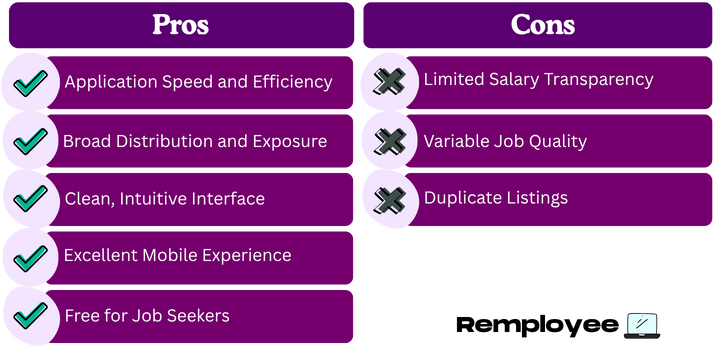
✅ The Pros: Where ZipRecruiter Excels
1. Application Speed and Efficiency
The one-click application system saves hours weekly. I applied to 63 jobs during my three-month search, requiring approximately 3-5 hours total application time. On platforms requiring individual submissions with cover letters and forms, the same volume would demand 20-30 hours.
2. Broad Distribution and Exposure
Your single application reaches multiple platforms and employer touchpoints. This amplification increases visibility without additional effort, particularly valuable for competitive markets where standing out proves difficult.
3. Clean, Intuitive Interface
The platform requires zero learning curve. Everything works exactly as expected, with no hidden features or confusing navigation. Job seekers can focus energy on applications rather than figuring out how the platform works.
4. Excellent Mobile Experience
The mobile app replicates desktop functionality effectively. I could manage my entire job search from my phone during commutes, lunch breaks, or while waiting in the dentist’s office. The convenience kept my search momentum consistent.
5. Free for Job Seekers
The robust free offering makes ZipRecruiter accessible regardless of financial situation. Unlike platforms with paywalls limiting search results or applications, ZipRecruiter provides full functionality at no cost.
❌ The Cons: Areas for Improvement
1. Limited Salary Transparency
The majority of job postings omit salary information entirely. This opacity wastes time for both candidates and employers when compensation expectations fail to align. Phone screens revealed misaligned expectations in approximately 30% of cases—frustrating for everyone involved.
2. Variable Job Quality
The large database includes everything from Fortune 500 opportunities to questionable commission-only sales positions disguised as management roles. Unlike curated platforms with strict vetting, ZipRecruiter requires candidate vigilance to identify problematic listings.
3. Duplicate Listings
The same position frequently appears multiple times through different recruiters or postings. I encountered situations where a single job appeared 4-5 times in search results, creating artificial inflation of apparent opportunities and requiring extra time to identify duplicates.
Best For / Not Ideal For
🎯 Perfect Match: Who Should Use ZipRecruiter
Entry to Mid-Level Professionals
Candidates seeking positions in the $35,000-85,000 range find the strongest listing concentration on ZipRecruiter. The quick application system particularly benefits those applying to numerous similar positions without requiring extensive customization for each.
Career Changers and Flexible Searchers
Job seekers open to multiple industries or role types benefit from ZipRecruiter’s broad database. The diverse employer mix and application ease encourage exploration across different fields without massive time investment.
Time-Constrained Job Seekers
Professionals conducting job searches while currently employed appreciate the efficiency. The mobile app and quick applications enable productive job hunting during lunch breaks, commutes, or other small windows of availability.
Remote Work Seekers
The platform’s strong remote job presence and specific remote-only filters serve candidates prioritizing location independence. Approximately 40% of professional listings offered remote or hybrid arrangements.
First-Time Job Seekers
Recent graduates or those entering the workforce find ZipRecruiter’s simple interface less intimidating than complex platforms like LinkedIn. The straightforward application process reduces barriers for those unfamiliar with job board navigation.
🚫 Probably Skip It: When Alternatives Work Better
Executive-Level Candidates
Senior positions above $150,000 appear infrequently on ZipRecruiter. Executive recruiters, LinkedIn, and specialized headhunting firms serve this segment more effectively. Of my 63 applications, only 2 targeted director-level roles, and neither generated responses.
Highly Specialized Technical Roles
Engineers, data scientists, and other technical professionals find better matches on specialized platforms like Stack Overflow Jobs, AngelList, or Hired. These niche boards attract employers specifically seeking technical talent, resulting in more relevant opportunities and better compensation transparency.
Academic and Research Positions
Universities and research institutions rarely post on ZipRecruiter. HigherEdJobs, ChronicleVitae, and academic professional organizations provide superior access to teaching and research opportunities.
International Job Seekers
The platform focuses heavily on US opportunities. Candidates seeking positions outside North America find limited relevant listings. International job boards specific to target countries provide better options.
Tips for Success
🚀 Profile Optimization Strategies
Complete Every Section
Profiles above 90% completion receive significantly more employer views. Invest the initial 30 minutes to thoroughly fill out your profile, including work history details, education, skills, and work preferences.
Use Keywords Strategically
ZipRecruiter’s algorithm matches keywords in your profile against job descriptions. Study postings for your target roles and incorporate frequently appearing terms naturally into your profile summary and job descriptions.
Update Your Profile Weekly
Regular updates signal active job seeking and can trigger renewed algorithm attention. Change your profile summary, add a skill, or update your work preferences weekly to maintain visibility.
Set Accurate Work Preferences
The work preference section (remote/hybrid/on-site, full-time/part-time, desired salary range) filters which jobs ZipRecruiter recommends. Accurate preferences improve matching quality and reduce irrelevant notifications.
📈 Application Best Practices
Apply Within 24-48 Hours of Posting
Jobs posted within the last two days receive the most employer attention. Early applications stand out before the employer receives hundreds of submissions. I had the highest response rate for applications submitted within 24 hours of posting.
Prioritize “Invite to Apply” Opportunities
When employers specifically invite your application, your profile already caught their attention. These invitations converted to interviews at nearly double the rate of standard applications in my experience.
Research Companies Before Applying
Spend 3-5 minutes researching each company before clicking apply. Check their website, read glassdoor reviews, verify the position appears on their official careers page. This screening prevents wasted applications to problematic employers.
Follow Up Strategically
When application status changes to “viewed,” consider sending a brief follow-up message through ZipRecruiter or LinkedIn. I sent follow-ups for my top 10 target positions, resulting in 3 additional phone screens that might not have occurred otherwise.
Track Your Applications Externally
Despite ZipRecruiter’s tracking features, maintain your own spreadsheet with application dates, companies, positions, and outcomes. This record proves valuable for identifying patterns and following up appropriately.
💡 Common Mistakes to Avoid
The Spray-and-Pray Trap
Easy applications tempt users to apply indiscriminately. Resist this urge. Target positions matching your qualifications and goals. I maintained a 19% interview conversion rate by applying only to roles where I met 70%+ of requirements.
Ignoring Job Description Details
Quick applications sometimes mean skimming descriptions rather than reading carefully. This approach leads to applying for positions requiring relocations you cannot make, schedules that do not match your availability, or qualifications you lack. Read thoroughly before clicking.
Failing to Customize High-Priority Applications
The one-click system works well for volume, but your dream positions deserve customized attention. For your top 5-10 target roles, supplement the quick application with a custom cover letter, direct outreach to hiring managers, or employee referrals.
Neglecting Mobile App Opportunities
Install the mobile app and enable push notifications. Some of my best opportunities appeared in mobile notifications during the day, allowing me to apply immediately while competitors waited until evening. Early application timing provided a competitive advantage.
Forgetting to Update Search Preferences
As your job search evolves, your preferences should too. I initially searched only for marketing roles but eventually expanded to project management and business development. Updating saved searches and profile preferences improved recommendation relevance.
Conclusion
🏆 Overall Rating Breakdown
The Bottom Line: Should You Use ZipRecruiter in 2025?
Yes—as part of a diversified job search strategy.
ZipRecruiter excels at what it promises: fast applications with broad distribution. During my three-month search, the platform contributed meaningfully to my success, generating 12 interview requests and ultimately playing a role in securing my current position.
However, ZipRecruiter works best as one tool among several rather than your exclusive platform. I used ZipRecruiter for volume and speed, LinkedIn for networking and researching companies, and Glassdoor for salary research and company reviews. This multi-platform approach covered all aspects of effective job searching.
The Math on My Experience:
- Investment: $0 (free account)
- Time spent: ~15 hours over 3 months
- Applications submitted: 63
- Interview requests: 12
- Final offers: 1
- Application-to-interview rate: 19%
Who Should Sign Up Today
✅ Immediate Yes:
- Anyone actively job searching
- Entry to mid-level professionals
- Candidates comfortable applying to multiple positions weekly
- Mobile-first users who need application flexibility
- Job seekers valuing time efficiency
⚠️ Supplement with Other Platforms:
- Senior-level professionals (use with LinkedIn, recruiters)
- Technical specialists (combine with Stack Overflow, AngelList)
- Career changers (add networking through LinkedIn)
- Location-specific searchers (add local job boards)
❌ Skip It Entirely:
- Executives seeking positions above $150K
- Academic job seekers
- International candidates outside North America
- Highly specialized roles in narrow fields
My Three Key Takeaways
- Speed Matters More Than You Think
The psychological benefit of easy applications maintained my job search momentum during discouraging periods. When rejection emails pile up, the ability to quickly apply to five new positions without enormous effort keeps your search active rather than stalling.
- Volume Creates Options
Applying to 63 positions over three months gave me 12 interview opportunities to evaluate. More options means better selection and stronger negotiating position. ZipRecruiter’s efficiency made this volume sustainable without burning out.
- Free Does Not Mean Inferior
Despite costing nothing, ZipRecruiter delivered results comparable to premium platforms. The free account provided everything necessary for successful job hunting, proving that expensive subscriptions sometimes offer marginal benefits at best.
🎬 Final Recommendations
My Personal Strategy:
- Create profiles on ZipRecruiter, LinkedIn, and Indeed
- Set up daily email alerts on all three platforms
- Use ZipRecruiter for quick applications to matching positions
- Use LinkedIn for company research, networking, and targeted applications
- Use Indeed for salary research and company reviews
- Apply to 15-20 positions weekly across all platforms
- Follow up on top 5 priority applications with direct outreach
Success Benchmark: If you apply to 20 positions on ZipRecruiter over two weeks and receive zero responses, reassess your profile, target roles, or qualifications. A 10-15% interview request rate suggests effective targeting.
📮 A Personal Note
Job searching tests patience and perseverance. After three months and 63 applications across multiple platforms, I finally accepted an offer for a position that checked every box on my wishlist. ZipRecruiter played a meaningful role in that success by making consistent application volume sustainable.
The platform will not revolutionize your job search. It will not magically create perfect opportunities where none exist. It will not replace networking, skill development, or interview preparation.
What ZipRecruiter will do: make the mechanical process of finding and applying to positions significantly faster and less painful. For a free tool, that value proposition delivers exactly what it promises.
Job searching remains challenging regardless of which platforms you use. ZipRecruiter removes some friction from the process, allowing you to focus energy on interviews, networking, and professional development rather than fighting with clunky application systems.
Use it. Combine it with other platforms. Stay persistent. Your next opportunity might come from ZipRecruiter—or it might come from a LinkedIn connection made possible because ZipRecruiter freed up time for networking.
Quick Action Steps
Today:
- Create your ZipRecruiter account
- Upload your current resume
- Complete your profile to 90%+
- Set up 3-5 saved job searches
- Apply to 3 positions immediately
This Week:
- Review all profile sections for accuracy
- Add 10+ relevant skills to your profile
- Research 10 target companies
- Set notification preferences
- Install and configure the mobile app
Ongoing:
- Check daily for new postings
- Apply to 3-5 positions per day during active search
- Update profile weekly
- Research companies before applying
- Track all applications in a spreadsheet
Last updated: October 2025. ZipRecruiter features may change. Individual results will vary based on industry, experience level, and local job market conditions.
Questions or corrections? Email us at Remployee.
💬 Frequently Asked Questions
Q: Can I really get a job through ZipRecruiter?
Yes. I secured interview requests for 12 positions during my three-month search, and several colleagues have successfully landed jobs through the platform. However, success depends on your industry, experience level, and how strategically you use the platform. ZipRecruiter serves as one effective tool in a comprehensive job search strategy.
Q: How long does it take to hear back after applying?
Response times varied dramatically in my experience. Some employers contacted me within 24 hours, while others took 3-4 weeks. About 60% of applications that resulted in interviews generated responses within one week. Applications that received no response after two weeks rarely resulted in interviews.
Q: Do employers actually look at ZipRecruiter applications?
The application tracking feature proves that many employers actively review submissions. During my search, approximately 70% of my applications showed “viewed” status, indicating genuine employer engagement. However, some companies use ZipRecruiter simply as a distribution channel and route applicants through their own systems, making tracking less reliable.
Q: Should I pay for ZipRecruiter Premium?
For most job seekers, no. The free account provides all essential functionality. I tested Premium for one month and found minimal benefit beyond the one-time resume review. Save your money for professional resume services, interview coaching, or industry certifications that provide more lasting value.
Q: How does ZipRecruiter compare to LinkedIn?
They serve different purposes. ZipRecruiter excels at application volume and speed, while LinkedIn dominates networking and company research. ZipRecruiter’s algorithm focuses on matching your profile to job descriptions, while LinkedIn emphasizes professional connections and relationship-building. Use both platforms simultaneously for optimal results.
After years of freelancing through broken systems and vague job boards, Josie built Remployee to help others find what she couldn’t at first: flexible work that feels like freedom, not chaos. She believes real jobs should fit real lives—and that thoughtful writing can be a bridge to better work. If you’re looking for permission to choose differently, Josie’s already given it.

